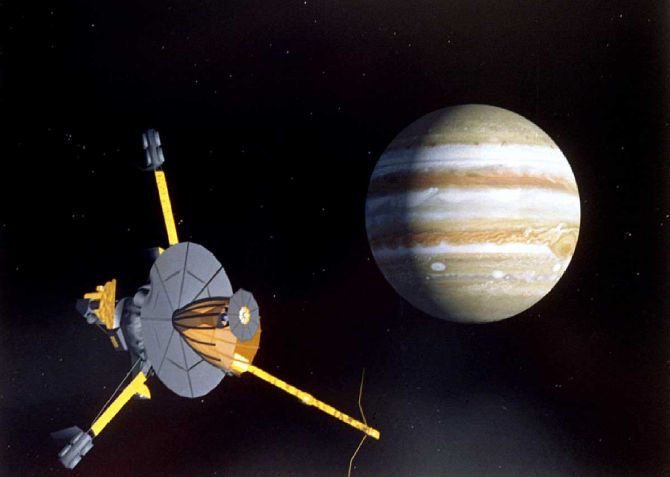The presence of phosphine in Venus's thick atmosphere has revived the age-old question: Are we alone.
Kumar Abishek explores the mysteries of the universe.

In 1990, when the Galileo spacecraft flew past Earth on its journey to Jupiter, it carried out an experiment developed by astronomer Carl Sagan to look for signs of life on Earth from Space.
The spacecraft found high levels of methane and oxygen in the atmosphere, suggesting photosynthesis was occurring on Earth's surface.
Since then we have been looking for such biosignatures not only in our solar system, but also beyond it.
Based on the Drake equation -- a formula proposed by astrophysicist Frank Drake to estimate the number of active, communicative extraterrestrial civilisations in the Milky Way -- there could be 100,000,000 planets with civilisations in our galaxy.
So far, we haven't even found a colony of microbes on other celestial bodies, let alone intelligent civilisations.
But the recent announcement of the presence of phosphine -- a biosignature -- in the upper part of Venus's thick atmosphere has revived the age-old question: Are we alone?
Also, the discovery of three buried -- possibly extremely salty -- water lakes on Mars, close to the one found around three years ago, has further intrigued scientists: A possible habitat for life?

Many scientists are sceptical; they argue there may be some unknown chemical reaction creating phosphine on Venus.
On Earth, phosphine is produced by microbes in anaerobic environment and by humans through a multitude of industrial processes.
It's extremely tough to produce this gas via other non-biological processes.
About Mars, experts say the water is much saltier than our seas.
How saline the lakes are on Mars isn't known, precisely.
Some microbes -- halophiles -- on our planet thrive in highly salty conditions, but studies have shown these can tolerate extreme salinity when temperature is high and extreme cold when salinity is low.
On Mars, while temperature is extremely low, water salinity is much higher, preventing such lakes from freezing.
Notably, methane has been reported in the Martian atmosphere and this has intrigued several geologists and astrobiologists, as this could be an indication of microbial life on the planet, or a geochemical process.

On Earth, life popped up as soon as it could -- around 3.5 billion years ago, merely 1 billion years (a short period in the geological time scale) after the planet was formed.
No one knows where life came from -- primordial soup, a solution rich in organic compounds in the primitive oceans, or asteroids that bombarded early Earth (a strong possibility; these space rocks had also brought water to our planet).
Earth wasn't the only planet that faced such a situation in the early solar system; it was more or less the same for Mars, Venus, and others.
Earth may not have been unique in witnessing life's birth.
It may not be unique now.
Also, the blueprint for life on Earth (terran life which is built from cells, exploits a metabolism that focuses on the carbonyl group, or C=O, and uses water as solvent and nucleic acids to perform most genetic functions) may not be universal.
We must broaden our definition of life, if there is any.

'We are so over-focused on finding a mirror image of Earth that we may overlook a planet that is even more well suited for life,' Dirk Schulze-Makuch, an astrobiologist at Washington State University in Pullman and the Technical University of Berlin, was quoted as saying by Space.com.
Researchers led him have identified two dozen exoplanets that are 'super habitable'.
Besides looking at planetary systems of yellow dwarf stars like the Sun, they considered orange dwarf stars -- cooler, dimmer and less massive than our star.
While the Sun has an estimated life of less than 10 billion years, orange dwarfs have lifetimes of 20 to 70 billion years.
The longer lifetime of orange dwarfs may give planets in their habitable zones more time to develop life and accrue biodiversity.
Our sun is actually not the best kind of star for hosting a planet with lots of life on it,' Schulze-Makuch argued.
Also, we must break the theoretical barrier of the Goldilocks Zone or the habitable zone -- the range of orbits around a star within which a planetary surface can support liquid water given sufficient atmospheric pressure (for Sun, roughly from Venus to Mars).
It was proposed by researchers in the 1970s and back then, it did not include even the entire Earth.
All life known in those days was confined to certain limits -- no colder than Antarctica, no hotter than scalding water, no higher than clouds, and no lower than a few mines.
We have been proven wrong.

We could be proven wrong again.
Consider Europa -- the fourth-largest moon of Jupiter.
Models suggest beneath the 5-km icy crust, this moon may have water oceans as deep as 50 km.
There is evidence that Europa may be slushy just beneath the crust and possibly warmer at greater depths -- big support for life.
Then there is Titan, Saturn's largest moon, with lakes and rivers brimming with organic molecules as products of the ammonia-methane chemistry.
It's highly unlikely that we are alone.
In the end, I cite a quote often misattributed to Sagan: 'Somewhere, something incredible is waiting to be known.'
Feature Presentation: Ashish Narsale/Rediff.com













 © 2025
© 2025